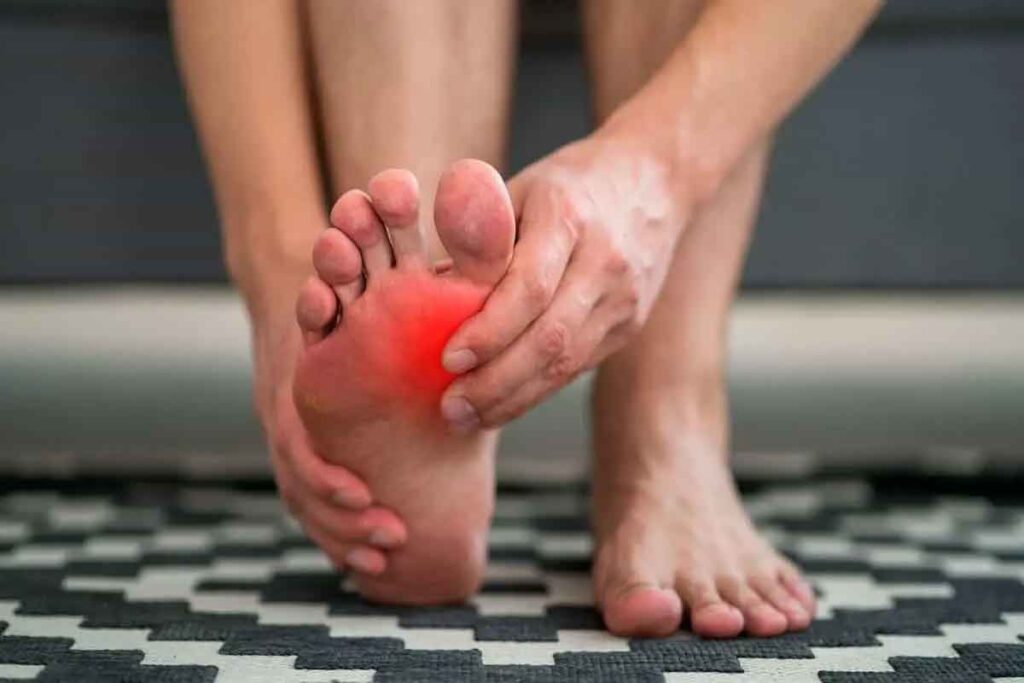
Foot pain and discoloration might be more than simple discomfort. At LivHospital, we focus on your safety and the latest in care. It’s important to know if you can develop a blood clot in your foot.
Can u get blood clots in your foot? Yes, blood clots in the foot are serious and can lead to big problems if not treated.
We know that blood clots can form in the foot. It’s not common, but it can happen. Our team works hard to find, stop, and treat these clots.

It’s important to know how blood clots form, as they can be risky, even in the feet. Blood clots are clumps of blood that turn from liquid to semi-solid. This happens naturally when we get injured. But, when it happens in deep veins, it can be dangerous.
Blood clots form through a complex process. When a blood vessel gets injured, the body tries to stop bleeding by forming a clot. This involves platelets sticking together and being strengthened by a protein called fibrin. While this helps us heal, it can sometimes cause clots in deep veins, known as Deep Vein Thrombosis (DVT).
Things like not moving much, having a family history, and certain health issues can raise your risk of getting harmful blood clots. Knowing these risks is key to preventing them.
Blood clots can happen anywhere in the body’s blood vessels. But, they most often show up in the deep veins of the legs, feet, and ankles. The legs are more at risk because of gravity and the pressure on veins when we stand or sit for a long time.
The foot’s vascular system is complex, with both superficial and deep veins. The deep veins are more likely to clot because of their anatomy and lower blood flow. Knowing the foot’s vascular structure is key for diagnosing and treating blood clots there.
We’ll explore more about diagnosing and treating foot blood clots later. But, understanding how they form is the first step in managing their risks.

Blood clots are often thought of as happening in the legs. But, they can also occur in the foot. This is less common but can be very dangerous, mainly for those with certain health risks.
Blood clots can happen anywhere blood flows, including the foot. But, they are less common in the foot than in the legs. This is because the foot’s blood vessels are smaller and blood clots are more likely in areas with slower blood flow.
Even though they are less common, people with risk factors should know about foot blood clots. This includes those who are immobile, have recently had surgery, or have certain health conditions.
There are two main types of blood clots in the foot: superficial thrombophlebitis and deep vein thrombosis (DVT). Superficial thrombophlebitis is less severe and affects superficial veins. DVT is more serious and can lead to a pulmonary embolism if the clot breaks loose.
Knowing the type of blood clot is key to the right treatment and care plan.
Foot clots are often missed because they are rare and symptoms can be similar to other, less serious conditions. The foot’s complex structure also makes diagnosis harder.
Healthcare providers need to be extra careful when looking for blood clots in the foot. This is true for patients with risk factors or unusual symptoms.
It’s important to know the signs of a blood clot in the foot. This is to avoid serious health problems. A blood clot in the foot can cause severe health issues if not treated quickly.
Visual signs are often the first clue of a blood clot in the foot. Look for swelling, redness, and skin color or texture changes. The skin might turn blue or red because of the clot blocking blood flow.
Watching for any changes in your foot’s appearance is key. These signs can mean there’s a clot.
Physical symptoms also hint at a blood clot in the foot. You might feel pain, warmth, and tenderness when touching the area. The pain can be a dull ache or sharp and stabbing.
These symptoms happen because the clot irritates the tissue and blocks blood flow. This leads to inflammation and discomfort.
| Symptom | Description |
| Pain | Dull ache or sharp pain in the foot |
| Warmth | Increased temperature in the affected area |
| Tenderness | Sensitivity to touch |
Symptoms of a blood clot in the foot can get worse if not treated. At first, symptoms might be mild. But they can get more severe, leading to more pain and swelling.
It’s important to watch how symptoms change. This helps figure out how serious the clot is and if you need medical help.
If you notice these symptoms, see a doctor right away. Early treatment can greatly improve your chances of recovery.
Knowing how a blood clot in your foot feels can help you get medical help fast. A blood clot in your foot can cause unexpected and worrying sensations.
A throbbing or constant pain is a key sign of a blood clot in your foot. This pain can be constant or intermittent and may get worse if not treated. The pain feels like a deep ache or a heavy feeling in your foot.
Some people might feel pain that radiates or spreads to other parts of their leg. It’s important to watch how the pain changes and get medical help if it gets worse or comes with other symptoms.
A blood clot can also cause burning sensations, numbness, or tingling in your foot. These happen because the clot affects blood flow and nerve function. The area might feel warm or hot to the touch, and you might see swelling or redness.
It’s hard to tell if the pain is from a blood clot or another foot problem, as many issues can cause similar symptoms. But, pain from a blood clot is usually more severe and persistent than from common foot injuries or conditions.
If you’re feeling any of these, you should see a doctor:
It’s important to know the signs and symptoms of a blood clot in your foot for early detection and treatment. If you’re unsure or if your symptoms get worse, don’t wait to get medical advice.
Blood clots in the foot can appear on the top or under the foot. Each has its own signs. Knowing these differences helps spot symptoms and get the right medical help.
A blood clot on the top of the foot can cause swelling and redness. The skin might feel warm, and it can hurt when pressed.
These signs can look like other issues, making it hard to diagnose. A detailed medical check is needed to find the cause.
A blood clot under the foot is tricky because of where it is. Walking or standing can make symptoms worse and even move the clot.
Key characteristics include:
Diagnosing a blood clot under the foot is harder because of the foot’s shape and the pressure it faces.
The spot of a blood clot in the foot changes how it’s diagnosed and treated. Clots on the top are easier to see and diagnose with exams and scans.
But, clots under the foot need more advanced tests like ultrasound or MRI to find and check them.
Treatment options may vary based on the clot’s location:
Knowing where a blood clot is in the foot is key to picking the best treatment.
Knowing the risk factors for foot blood clots can help individuals take preventive measures. Certain medical conditions, lifestyle factors, and personal characteristics can increase the likelihood of developing blood clots in the feet.
Several medical conditions can predispose individuals to blood clots in the feet. These include:
Lifestyle factors play a significant role in the development of blood clots in the feet. These include:
It’s essential to be aware of these factors and take regular breaks to move around, even during long trips.
Demographic and genetic factors can also influence the risk of developing blood clots in the feet.
| Factor | Description | Risk Level |
| Age | Risk increases with age, specially after 40 | Moderate to High |
| Gender | Some studies suggest women are at higher risk, specially during pregnancy | Moderate |
| Genetic Predisposition | Family history of blood clots or clotting disorders | High |
Surgery and injuries can significantly increase the risk of blood clots in the feet due to immobility and the body’s response to trauma.
Understanding these risk factors can help individuals and healthcare providers take necessary precautions to prevent blood clots in the feet.
It’s key to understand how chronic foot pain and blood clots are linked. Foot pain can be a sign of a blood clot, but it can also stem from other issues.
Recognizing the signs of a blood clot is vital. Throbbing pain, swelling, and warmth in the foot could mean a blood clot. But, these signs can also point to other problems, making it hard to diagnose.
Chronic foot pain can come from many sources. Overuse, injury, or medical conditions can all cause it. If the pain lasts and there’s no clear reason, a blood clot might be a possibility.
Other issues can make symptoms of a blood clot seem like something else. Plantar fasciitis, tendonitis, and infections can all look like a blood clot. It’s important to tell them apart to get the right treatment.
| Condition | Symptoms | Differential Diagnostic Features |
| Blood Clot | Pain, swelling, warmth, redness | Positive D-dimer test, ultrasound findings |
| Plantar Fasciitis | Heel pain, pain with first steps | Tenderness along the plantar fascia, absence of swelling |
| Tendonitis | Pain, swelling along the tendon | Pain with movement, tenderness along the tendon |
Ignoring chronic foot pain can lead to serious issues, like a blood clot getting worse. If you think you might have a blood clot, get medical help right away. This can stop serious problems like a pulmonary embolism.
We stress the need to see a doctor if you have ongoing foot pain. Early treatment can greatly improve your chances of feeling better.
Untreated foot blood clots can be very dangerous. They can lead to serious health issues, some of which can be deadly. It’s important to get them treated quickly.
A blood clot in the foot can be serious. In bad cases, it can be life-threatening. If it breaks loose, it might block a vital organ like the lungs.
This is called pulmonary embolism and is very dangerous. It needs quick treatment to avoid death.
Foot blood clots also have long-term risks. These can affect your life quality a lot.
Deep Vein Thrombosis (DVT) happens when a clot forms in a deep vein, usually in the legs. If not treated, it can cause a pulmonary embolism. Symptoms include swelling, pain, and redness in the leg.
Pulmonary embolism is a serious emergency. It needs fast help. Symptoms include:
Post-thrombotic syndrome (PTS) is a long-term issue from DVT. It happens when the clot damages vein valves. This leads to chronic symptoms like pain, swelling, and skin color changes.
PTS symptoms like pain and swelling can really affect your daily life. Managing it often means ongoing medical care and lifestyle changes.
Seek medical help right away if you have symptoms of a pulmonary embolism or worsening DVT signs. Quick treatment can greatly improve your chances and reduce risks.
If you have severe chest pain or trouble breathing, or if your leg is swelling, pain, or red, get emergency care. These are signs you need help fast.
Acting quickly is key to avoiding serious problems from foot blood clots. If you’re at risk or have symptoms, talk to a healthcare professional right away.
Understanding how to diagnose and treat blood clots in the feet is key to better health. Doctors use many tests and treatments to help patients. This approach is vital for good care.
Tests are important to find blood clots in the feet. The main tests are:
These tests help doctors find blood clots and choose the best treatment.
Doctors use medicines to treat blood clots in the feet. Anticoagulants stop the clot from getting bigger and prevent new ones. Thrombolytics dissolve the clot.
The right medicine depends on the patient’s health and the clot’s size and location. Doctors watch patients closely to avoid problems.
Sometimes, doctors need to do procedures or surgery for blood clots in the feet. These can include:
These steps are for big clots or when there’s a high risk of problems.
How long it takes to recover from blood clots in the feet varies. It depends on the treatment and the person’s health. Patients on medicine need regular check-ups to adjust their treatment.
It’s important for patients to know the signs of complications. They should get medical help if they have unusual symptoms during recovery.
Preventing blood clots needs a full plan. This includes making lifestyle changes and knowing your risk factors. Getting medical help quickly is also key.
At LivHospital, we stress the need to know about blood clot risks. We teach how to lower these risks. Regular exercise, a healthy weight, and not sitting too long are important.
People who have had blood clots or are at high risk should talk to their doctor. They can make a plan to prevent blood clots. This might include medicines, special stockings, and check-ups.
By being proactive and knowing the signs of blood clots, you can lower your risk. We aim to give top-notch healthcare and support to all our patients.
Yes, blood clots can happen in the foot, though it’s less common than in the legs. It’s important to know the risks and look out for signs and symptoms. This helps in getting medical help quickly.
A blood clot in the foot can cause throbbing pain and numbness. You might also feel burning sensations and tingling. The pain can get worse if not treated.
Signs of a blood clot in the foot include swelling and redness. The area might feel warm and the skin could look discolored or pale.
Yes, a blood clot in the foot can be serious if not treated. It can lead to pulmonary embolism, which is dangerous. It’s vital to get emergency care if symptoms get worse.
Several factors can increase the risk of blood clots in the feet. These include medical conditions, lifestyle choices, age, gender, and genetics. Risks also come from surgery and injuries.
Doctors use tests like ultrasound and D-dimer tests to find blood clots in the foot. They also use imaging. A detailed approach is needed to diagnose and treat blood clots accurately.
Treatment for blood clots in the feet includes medicines and procedures. The choice depends on the clot’s severity and location. Options range from medical treatments to surgery.
Yes, chronic foot pain can be a sign of a blood clot. But, it’s important to tell it apart from other conditions. If you have persistent pain, don’t ignore it and seek medical help.
Preventing blood clots in the foot involves making lifestyle changes and being aware of risks. Understanding the risks and taking steps to prevent them is key. This includes getting medical help when needed.
Untreated foot blood clots can cause long-term problems. These include post-thrombotic syndrome, leading to chronic pain and swelling. Getting medical help quickly is important to avoid these issues.
Subscribe to our e-newsletter to stay informed about the latest innovations in the world of health and exclusive offers!
WhatsApp us